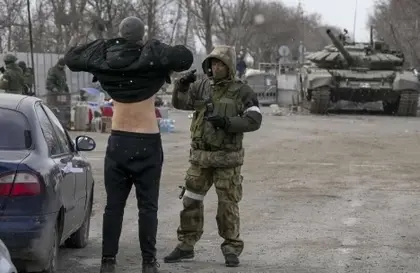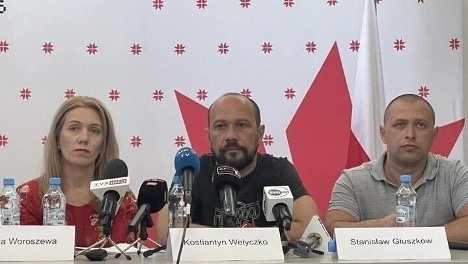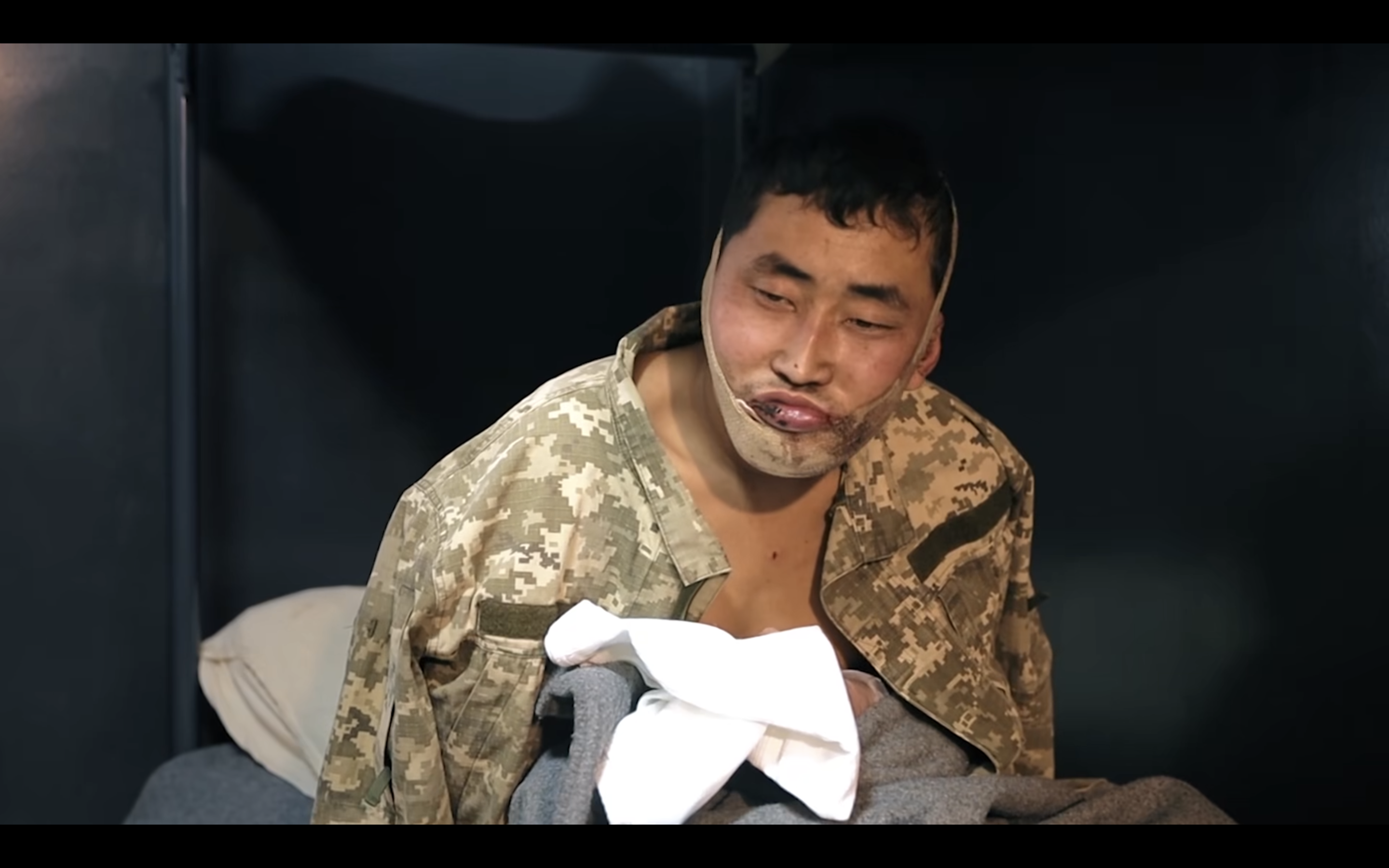Before Russia launched its full-scale invasion of Ukraine on Feb. 24, Kostiantyn Velychko worked in IT. He conducted training on strengthening stress resistance and overcoming the consequences of negative situations. This knowledge was probably one of the factors that helped him to endure more than 100 days of incarceration at Olenivka prison.
Originally from Mariupol, Kostiantyn started volunteering when the war began. He and his team were involved in coordinating humanitarian assistance, issuing passes, organizing safe evacuation routes and delivering humanitarian aid.
JOIN US ON TELEGRAM
Follow our coverage of the war on the @Kyivpost_official.
It wasn’t long until Kostiantyn was making trips to Berdiansk in the Donetsk region. He helped evacuate people and delivered vital food and medicine to those close to the frontline. Every day it became more and more difficult to travel because the Russian military got to know the volunteer crossing checkpoints. The volunteers were searched with increasing regularity and often stripped naked. The psychological pressure on volunteers increased as a result.
On March 28, Kostiantyn and his colleague Stanislav Glushkov decided to travel directly from Zaporizhzhia to Mariupol. However, reports were proliferating that volunteers were being turned back, leaving the team worried that their ability to enter the city would soon be completely closed off.
Despite the team already having experience in communicating with the Russian military, knowing the rules of movement and having the necessary volunteer certificates, badges and car stickers, they were still stopped. Moreover, when the Russians discovered that they were volunteers, they accused them of volunteering for disingenuous reasons. Kostiantyn and Stanislav suggested that the military go with them to see how they evacuated women and children, but the military instead ordered that they follow them to Nikolske, Donetsk region.

British Defence Intelligence Update Ukraine 23 January 2025
“Once there, we realized we were not the first arrested volunteers. Moreover, the Russians were detaining volunteers deliberately to cause a humanitarian disaster in the occupied territories,” Kostiantyn told Kyiv Post.
After a day behind bars in Nikolske, handcuffed and with bags over their heads, the men were taken to Starobesheve for a day.
“We were cross-examined and then placed in an overcrowded cell without proper conditions. They put us on our knees on the concrete and clicked the slides of their pistols against our heads,” recalls Kostiantyn.
Kostiantyn and Stanislav were then held for another day in a special detention center for combating organized crime, where they were once again interrogated and searched, before being sent to Olenivka.
“[At Olenivka] we were bound with tape and forced to squat with our hands behind our heads for several hours. In such a posture, pressure in the body rises quickly and blood vessels start to burst. But change position and they will beat you; fall and they will beat you until you get up,” the captured volunteer says.
Prisoners of War (POWs) were overseen by Russian soldiers, Federal Security Service (FSB) officers, the Investigative Committee of the Russian Federation and members of the military HQ. Meanwhile, civilians – namely volunteers – were overseen by relevant authorities subordinate to the Donetsk People’s Republic (DPR).
After another interrogation, the volunteers were filtered into a single cell, barely fit for humans at all. All those who failed the filtration process were sent to the department for combating organized crime for further interrogation. As a result of a bogus set of inquiries, the detained volunteers were typically sentenced to 10 years or more in prison in absolutely inhumane conditions.
“We were kept in the cold, denied access to fresh air for more than two weeks and were barely fed. We had to sleep in shift patterns because there were 50 people in a cell measuring 12-14 square meters so we couldn’t all lie down at the same time,” describes Kostiantyn.
After that, some of the volunteers were moved to barracks, where they were forced to repair the premises every day from 06:00 a.m. till 10:00 p.m. Later, the captured defenders of the Azovstal Steelworks were settled into the renovated barracks.
“When the Red Cross arrived, its members were shown the renovated rooms with beds, mattresses, etc. So, that presented a nice picture with good conditions. Later, they began inviting journalists from their own propaganda channels, with Oleksandr Sladkov being one of them,” says Kostiantyn.
The journalists did actually see the real detention conditions – after all, the prison is not big: 5-6 buildings housing about 2,000 prisoners – but these conditions were never shown by the controlled media. The Russians blackmailed those whose families remained in the occupied territories, forcing them to give interviews claiming that the detention conditions were good.
“POWs were told that Ukraine had forgotten about them and that they would remain imprisoned forever, but they had the opportunity to call their relatives and inform them of their whereabouts. In exchange for this privilege, they were forced to take part in videos posted online calling on the Ukrainian military to surrender,” Kostiantyn explains.
Later, the volunteers were moved to a higher security zone – a separate building with a concrete yard covered with a net where the prisoners were forced to work.
During the first five days, the POWs were given only a piece of dry bread and 170 ml of water per day. Later, the menu improved a little: they were given tough and barely edible pasta; a light brownish water that was meant to be tea; a watery “soup” containing a few pieces of cabbage and a piece of onion; and cereal that had been cooked in a vat previously used to hold fish. The menu didn’t change from one day to the next. When new people arrived, the portions were reduced accordingly and there was a constant and severe shortage of water.
According to Kostiantyn, there were rare occasions when someone who worked outside the prison would come there for certain reasons to help the prisoners, including bringing food or medicine.
“Most of the prison workers took pleasure in abusing the inmates. They constantly humiliated and brutally beat them. Volunteers were often physically abused at the beginning of their imprisonment. I was whipped on the head, body and hands if I was seen to be sitting, standing, or talking ‘incorrectly.’ Other civilians were tortured using electric shock treatment, forced to dig graves and so on. And when the military from Azovstal were brought to the prison, they were beaten and tortured in isolation cells so that other prisoners could not look on,” Kostiantyn recalls.
Kostiantyn singles out three cases that are now etched in his memory. On one occasion, when new prisoners arrived, four men were beaten so badly that they could not stand for four or five days. In another case, a prisoner picked two cherries from a senior officer’s garden and was sent to an isolation cell in unbearable conditions. And the most terrifying case was of an Azovstal defender being driven to suicide. Before that, the guards visited him in his cell several times, exerting psychological pressure and physical violence.
“On the night before he took his own life, one of our volunteers, Hanna Vorosheva, heard part of a conversation between the guards and the prisoner. They asked him whether he understood everything and would do everything correctly. The next day, he slit his wrists. This would normally be difficult to do in an isolation cell because everyone is carefully searched. Yet he was found with disassembled razor blades,” Kostiantyn notes.
The volunteers were kept as administrative detainees for 30 days, but this term was repeatedly extended. Given that civilians could not be exchanged as POWs, the process of releasing them was slow.
On July 4, Kostiantyn and several other volunteers were issued with a document stating that “the initiation of a criminal case was refused” and they were released. Fortunate to be free, they made their way to Donetsk and from there to other destinations.
“For two months, no one was released from the prison – only moved between institutions. For example, many military men were taken to Russia or the Luhansk/Donetsk People’s Republics. More than 500 people imprisoned for 10 years or more are now in the Donetsk pretrial detention center. During my imprisonment, about 5,500 people passed through, and when we were released, about 2,000 remained. Some were exchanged, but most of the POWs, as we all understand, were taken to unknown destinations,” Kostiantyn concludes.
Kostiantyn was able to endure the torture and terrible conditions of detention for so long due to the shared help and support among imprisoned volunteers. Knowing that their relatives and friends knew of their whereabouts and were actively trying to free them also helped them to hold on.
Hanna Vorosheva, Kostiantyn Velychko and Stanislav Glushkov at a press conference in Warsaw on June 21, 2022 © Viktor Semashkevych
You can also highlight the text and press Ctrl + Enter











